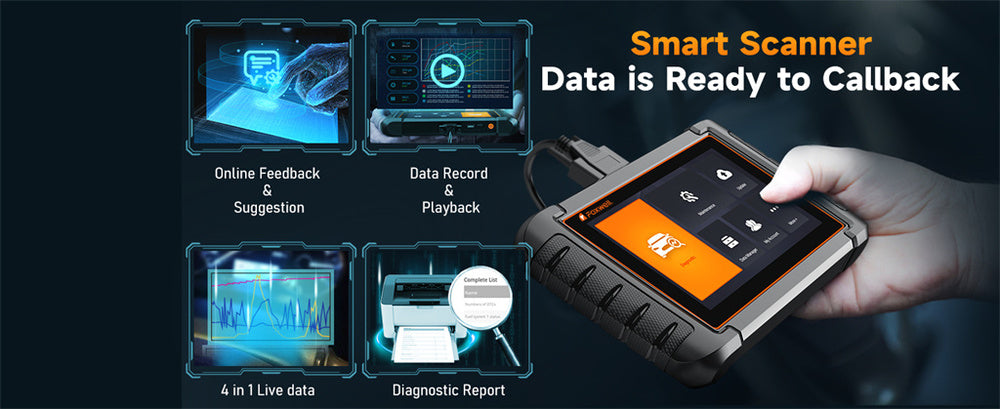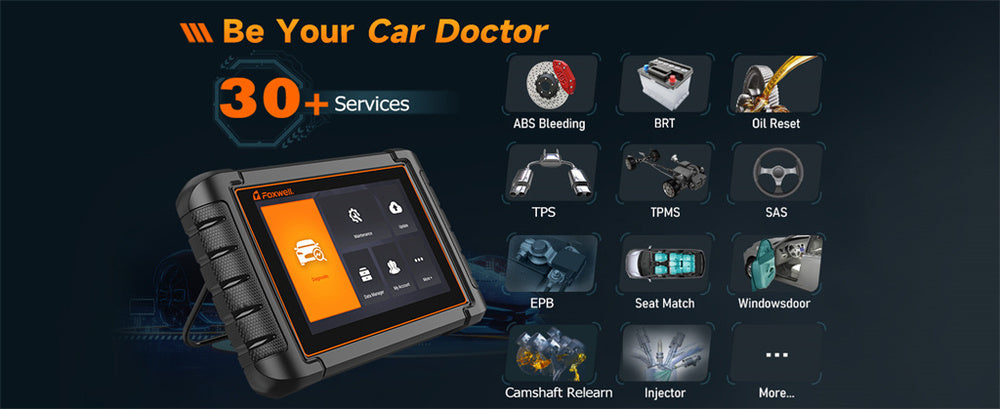Given its complexity, maintaining your vehicle's health is increasingly essential in today's fast-paced world. Early identification of any issues will save time, money, and hassle.
An OBD2 scanner is an essential tool that empowers car owners and mechanics alike to diagnose potential problems quickly and accurately. This article will outline its purpose, use, and any warning signs you shouldn't ignore.
What Is an OBD2 Scanner Used For?

An OBD2 scanner is an indispensable vehicle diagnostics device designed to communicate with your car's onboard computer system and provide crucial diagnostic insights.
OBD2 scanners primarily monitor various vehicle systems, such as engine, transmission, and emissions systems.
Doing this helps ensure everything is functioning effectively.
When an issue arises, the OBD2 system generates diagnostic trouble codes (DTCs).
These codes serve as diagnostic tools, pinpointing precisely which issue exists in your vehicle.
P0300 indicates an engine misfire.
OBD2 scanners deliver real-time performance metrics like RPM, fuel efficiency, and coolant temperature in real-time.
This information can help you recognize any unusualities during your drive.
Utilizing an OBD2 scanner regularly is one of the best ways to ensure preventative vehicle maintenance.
By identifying issues early, you can address them before they lead to expensive repairs - similar to going for regular check-ups at a doctor's office to protect against illness.
In the long term, investing in an OBD2 scanner could save money.
Catching problems early often results in more minor, less expensive repairs than waiting until a major failure occurs.
By understanding the practical applications of an OBD2 scanner, you can better maintain and extend the lifespan of your vehicle.
Recognizing Red Flags and Understanding Warning Signs
Knowing and understanding red flags within your vehicle is critical for proper maintenance.
Warning signs can take various forms, such as dashboard lights, unusual noises, or changes in performance.
Dashboard warning lights serve as your car's main form of communication.
Each light provides vital information about the health of your vehicle.
A check engine light is a general warning sign, indicating something requires attention.
This issue could become much more significant down the road by neglecting it.
Attention must be paid to any peculiar noises or vibrations while driving.
Rattling noises could indicate loose parts while grinding sounds could indicate brake issues.
These symptoms should serve as warnings in your mind, prompting you to act before an otherwise minor problem becomes costly to fix.
Changes in performance, such as reduced acceleration or shifting gears, should also serve as warning signals.
These issues may compromise both your safety and overall driving experience.
They indicate something is amiss and should be investigated promptly.
Taking swift and decisive action is imperative when you detect an alarm bell.
Delaying repairs can quickly turn from an annoying inconvenience into a major hassle.
An OBD2 scanner regularly helps you stay ahead of maintenance and repair needs, enabling timely servicing and repairs.
Becoming more proactive and alert is the best way to keep your vehicle operating smoothly and increase road safety.
How to Use an OBD2 Scanner to Spot Red Flags
Utilizing an OBD2 scanner such as the Foxwell GT60 is simple and efficient for identifying vehicle issues.
Here's how it works:
- Connect the Scanner: Locate your vehicle's OBD2 port - typically found underneath its dashboard near the driver seat - and plug in a Foxwell GT60 scanner.
- Turn on the Ignition: Before starting your vehicle, switch the ignition on so the scanner can effectively communicate with its onboard computer.
- Pressing the Power Button: To activate the Foxwell GT60 scanner, press its power button; it will boot up and ask for information regarding your vehicle's make and model.
- Select the Diagnostic Mode: Navigating through the menus allows you to select the diagnostic mode. The Foxwell GT60 provides various options, such as reading codes and live data.
- Diagnostic Trouble Codes (DTCs): Use DTCs to quickly and efficiently identify potential problems with your machine. Brief descriptions help you understand what may be going wrong. The display will show codes and brief explanations so you may more quickly recognize where trouble may be.
- Check Live Data: Take advantage of live data monitoring to keep a watchful eye on real-time performance metrics such as RPM, vehicle speed, and fuel trims in real-time. Keep an eye out for any anomalies which might signal problems.
- Interpret Results: Study your data and codes carefully. The Foxwell GT60 offers thorough explanations to help you understand the severity of any potential issues.
- Clear Codes as Necessary: Once you have addressed any identified problems, clearing codes to reset the system allows you to monitor whether any similar issues resurface in the future.
- Follow-Up: Use the scanner frequently to monitor your vehicle's health. Regular checks can help detect early warnings that could compromise its operation, helping ensure smooth running and keeping red flags at bay.
By choosing to use the Foxwell GT60, you gain control over your vehicle's maintenance, guaranteeing safer and more reliable driving experiences.
Common Diagnostic Trouble Codes (DTCs) That Signal Red Flags
Its P0300: Random Misfire Detected.
Indicates that one or more cylinders are misfiring, leading to reduced performance and higher emissions. P0420 suggests this problem is present.
Signals indicate that the catalytic converter is not functioning optimally, affecting exhaust system performance and fuel economy. P0171 indicates a system that is too lean (Bank 1).
P0455 indicates an Evaporative Emission Control System Leak Detected with a Large Leak.
P0131 indicates a leak in the fuel system, leading to increased emissions and fuel loss. This alert should also trigger P0130: Oxygen Sensor Circuit Low Voltage (Bank 1, Sensor 1) warning lights on the dashboard.
Indicates an issue with the oxygen sensor, compromising fuel economy and emissions control. P0128: Coolant Thermostat Range/Performance Problem
Knowing and understanding DTCs allows you to recognize potential issues with your vehicle and schedule timely maintenance or repairs as soon as they arise.

Understanding Warning Lights in Your Vehicle
Your dashboard's warning lights provide crucial insights into your car or truck's condition. They serve as a barometer of its health and should always be treated as important signs.
Your car's warning lights serve as a way of alerting you of potential issues that require immediate attention.
For example, the check engine light serves as a general warning system.
Signs of trouble range from minor ones, like a loose gas cap, to major engine malfunction.
Neglecting this light could result in costly repairs down the line.
A critical light is the oil pressure indicator.
If the light comes on, it indicates low oil pressure that could result in engine damage if not addressed immediately.
The battery warning light alerts drivers of potential vehicle charging system issues.
If this light comes on, you must immediately check your battery and alternator to prevent getting stranded.
Understanding these warning lights is crucial to maintaining the health of your vehicle.
Each light signifies something specific, and acting quickly can prevent more minor issues from becoming major ones.
By regularly monitoring your dashboard indicators, you can identify potential red flags early and ensure a safer driving experience.
Conclusion
An OBD2 scanner is a practical, proactive strategy for vehicle maintenance that can save both time and money in maintenance costs while alleviating unnecessary stress.
By learning how to utilize these scanners efficiently, recognize warning signs, and become acquainted with diagnostic trouble codes, you will gain the tools and confidence needed to take charge of your vehicle's health.
Staying informed is critical to keeping your vehicle running efficiently, whether that means regular diagnostic checks or being alert for red flags.
By being vigilant and using tools such as the Foxwell GT60, you can ensure a safer and more reliable driving experience that extends the lifespan of your vehicle.
FAQs
Can a car scanner detect electrical problems?
Yes, many OBD2 scanners can detect electrical problems, such as issues with sensors, wiring, and the battery. They often flag trouble codes related to electrical components, allowing for further diagnosis.
Do you have to turn on the car for OBD2 scanner?
No, you don’t need to start the engine, but the ignition must be in the "on" position (with the engine off) to allow the scanner to communicate with the car’s onboard system.
What is the difference between an OBD2 reader and an OBD2 scanner?
An OBD2 reader typically only reads and clears codes, while an OBD2 scanner provides more detailed diagnostics, including live data, sensor readings, and advanced functions like freeze frame data or component testing.




Leave a comment
This site is protected by hCaptcha and the hCaptcha Privacy Policy and Terms of Service apply.